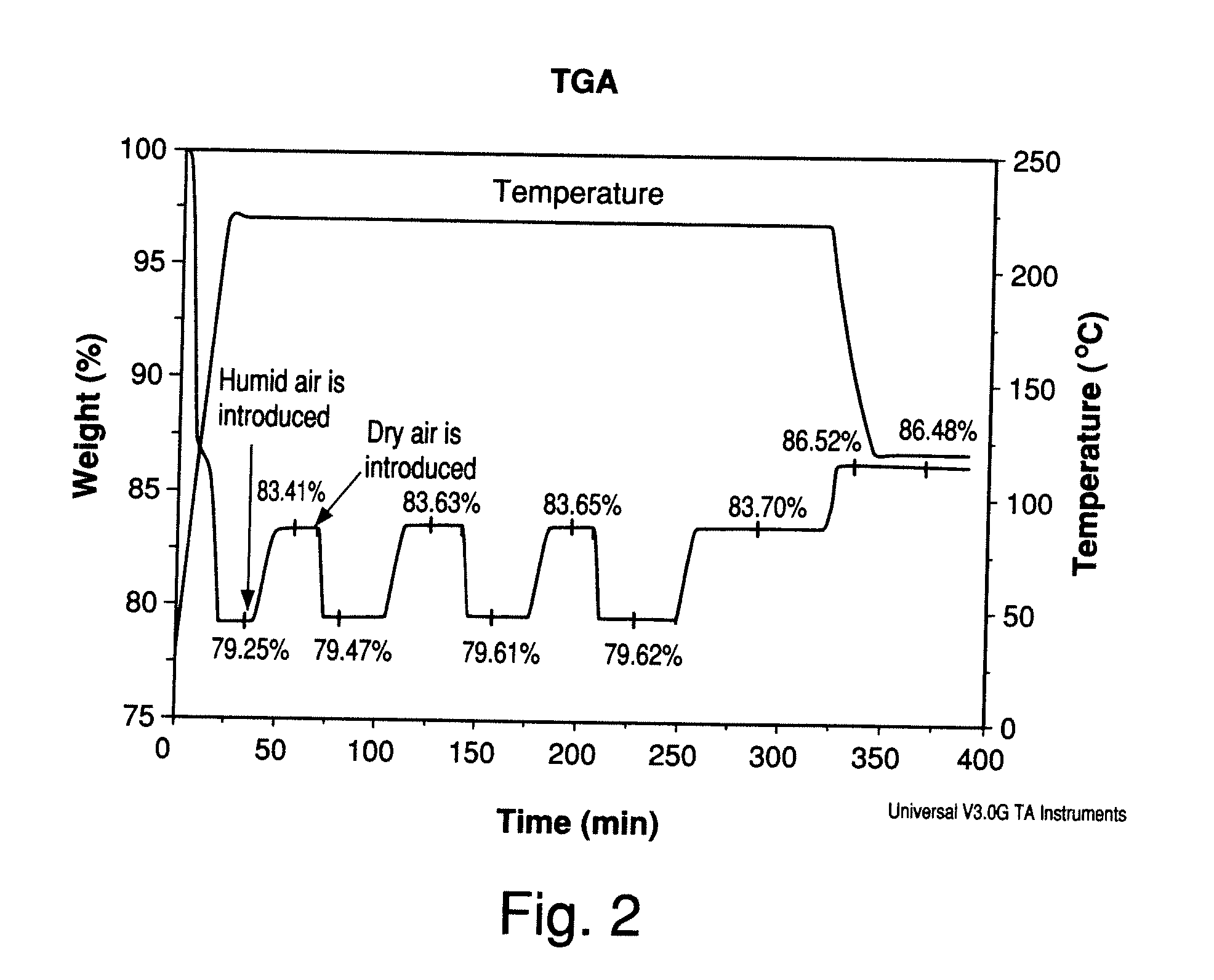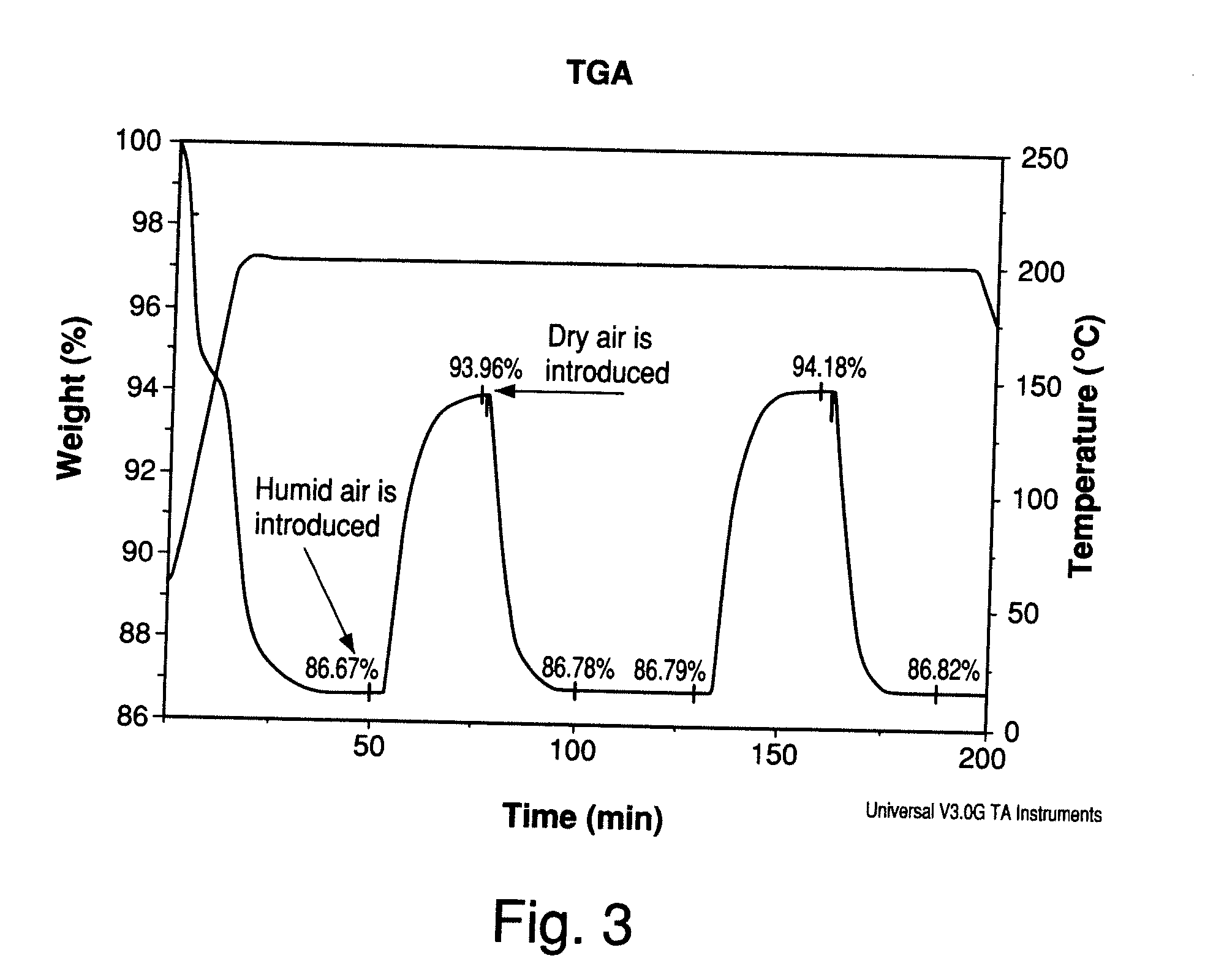Proton Conducting Mediums for Electrochemical Devices and Electrochemical Devices Comprising the Same
a technology of electrochemical devices and conducting mediums, applied in the direction of diaphragms, silicon organic compounds, conductive materials, etc., can solve the problems of loss of active sites for oxygen reduction, high cost of sources, and difficulty in achieving high conductivity, so as to improve the solvent for oxygen synthesis and less sensitive to co poisoning
- Summary
- Abstract
- Description
- Claims
- Application Information
AI Technical Summary
Benefits of technology
Problems solved by technology
Method used
Image
Examples
example 1
Preparation of [Et3NH]2B12FxH12-x (x=10, 11, or 12)
[0065] A slurry of 2.01 g K2B12H12CH3OH in 10 g glacial acetic acid was fluorinated at 20° C. with a gaseous mixture of 10% F2 / 10%O2 / 80% N2 (% are by volume). A total of 116 mmol F2 was added (22% excess). The slurry remained colorless throughout the fluorination and while its viscosity decreased complete dissolution of the solid was never observed. At the completion of the fluorination, the product slurry gave a negative iodide test for oxidizer. Solvents were then evacuated and the crude product dissolved in water. Triethylammonium hydrochloride (240 mmol) was added along with enough triethylamine to bring the solution pH up to 5. The product was filtered, washed with water and dried. 3.2 g (65% yield) of fluoroborate salts were isolated. 19F NMR analysis showed B12F10H22− (7%), B12F11H2— (18%), and B12F122− (75%) with only traces of hydroxy-substituted impurities. The crude reaction product was dissolved in water and the pH of t...
example 2
Fluorination of K2B12H12 With Fluorine in Formic Acid (15% Loading; O2 Added)
[0066] In this example, a colorless slurry containing 1.8 g (7.2 mmol) K2B12H12CH3OH in 10 ml formic acid was fluorinated at 0 to 10° C. as described in Example 1. A total of 108 mmol F2 (25% excess) was added as 10% F2 / 10%O2 / 80% N2. Over the course of the fluorination, the solids completely dissolved leaving a colorless, homogeneous solution at the completion of the fluorination. Analysis of the crude product solution by 19F NMR revealed primarily B12F11H2— (35%), and B12F122− (60%) and approximately 5% of the monohydroxy impurity B12F11OH. No dimer impurity was observed. Isolation of the product through the triethylammonium salt as above removed impurities and gave the above fluorinated borate cluster products in 80% yield.
example 3
Preparation of H2B12F12.n H2O by direct fluorination of H2B12H12.n H2O
[0067] The fluorination of 2 weight % solution of H2B12H12.6H2O in HF at about −15° C. with 20% F2 in N2 afforded B12F122− with a very low content of the other anions (side-products). Based on the 19F NMR spectrum of the crude reaction mixture, the molar ratio of the anions were: B12F122− (1), B24F224− (0.01), B12F11(OH)2− (0.05) and BF4— (0.36). Approximately 3 mol % of B12H122− has to decompose during the reaction to produce the molar ratio of BF4— to B12F122−0.36. Thus, the yield of H2B12F12.n H2O in the above reaction was close to 90%.
PUM
| Property | Measurement | Unit |
|---|---|---|
| temperature | aaaaa | aaaaa |
| temperature | aaaaa | aaaaa |
| temperatures | aaaaa | aaaaa |
Abstract
Description
Claims
Application Information
 Login to View More
Login to View More - R&D
- Intellectual Property
- Life Sciences
- Materials
- Tech Scout
- Unparalleled Data Quality
- Higher Quality Content
- 60% Fewer Hallucinations
Browse by: Latest US Patents, China's latest patents, Technical Efficacy Thesaurus, Application Domain, Technology Topic, Popular Technical Reports.
© 2025 PatSnap. All rights reserved.Legal|Privacy policy|Modern Slavery Act Transparency Statement|Sitemap|About US| Contact US: help@patsnap.com



